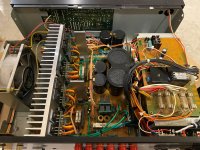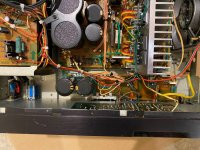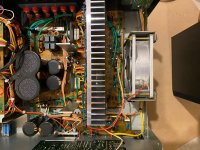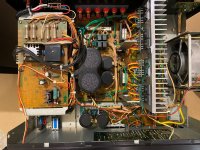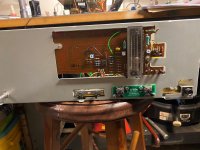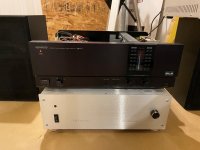Only two questions, opinions are welcome.
Should I replace the carbon film resistors with metal film 1%. (Over time the Carbon film can get out of tolerance and can be noisy)
Some of the electro capacitors in the kit have IMO way to high of a voltage value for the voltage applied. Parts of the circuit that have less than 10 volts on it used 10v capacitors, (Factory). The replacements have a value of 100 volts. I can see going to maybe 16 volts but 100 is a bit much.
Should I use caps that are closer to the original value? The amp has worked for 30+ years.
I have the time to sit at the bench, don't mind the work.
Should I replace the carbon film resistors with metal film 1%. (Over time the Carbon film can get out of tolerance and can be noisy)
Some of the electro capacitors in the kit have IMO way to high of a voltage value for the voltage applied. Parts of the circuit that have less than 10 volts on it used 10v capacitors, (Factory). The replacements have a value of 100 volts. I can see going to maybe 16 volts but 100 is a bit much.
Should I use caps that are closer to the original value? The amp has worked for 30+ years.
I have the time to sit at the bench, don't mind the work.
There is no harm in using higher voltage rated electrolytic capacitors and there is no too much. High voltage ratings can mean that the capacitors have better performance. With old stuff it may even work out best with regards to physical properties as old caps were quite large. Make sure you buy ones with exactly the right pitch. No extension wires and long lead wires please. I recall the M2 having 6.3 and 10V caps which is quite lowly rated thinking of power on/off behaviour and high rail voltages. I even think it was one of the known failures?!
Yes do replace the old resistors with metal film types by a reputable brand and it won't hurt to use a slightly higher power rating for those. Take a close look to resistors that have discoloration of the PCB and make sure to use higher power rated resistors there and mount them with a few mm clearance.
Not too familiar with the M2 anymore (it is too long ago) but old amplifiers often have polarized caps in the feedback loop. It is better to use bipolar caps there like the MUSE ES. Also use higher voltage ratings when possible and try to find the same physical size and pitch.
Input capacitors are often electrolytic caps in 5 mm pitch. These can easily be replaced for 5 mm film caps with better sound quality and no need to replace these after many years.
* reflow ALL solder joints with good old 60/40.
** check output relay and replace it if it has gold plated contacts.
*** 10V rated electrolytic caps in 5 mm pitch and with values till 4.7 µF can be replaced for Wima MKS 5 mm 50V film caps when they're in the signal path (coupling caps) and/or VAS/driver circuits.
Yes do replace the old resistors with metal film types by a reputable brand and it won't hurt to use a slightly higher power rating for those. Take a close look to resistors that have discoloration of the PCB and make sure to use higher power rated resistors there and mount them with a few mm clearance.
Not too familiar with the M2 anymore (it is too long ago) but old amplifiers often have polarized caps in the feedback loop. It is better to use bipolar caps there like the MUSE ES. Also use higher voltage ratings when possible and try to find the same physical size and pitch.
Input capacitors are often electrolytic caps in 5 mm pitch. These can easily be replaced for 5 mm film caps with better sound quality and no need to replace these after many years.
* reflow ALL solder joints with good old 60/40.
** check output relay and replace it if it has gold plated contacts.
*** 10V rated electrolytic caps in 5 mm pitch and with values till 4.7 µF can be replaced for Wima MKS 5 mm 50V film caps when they're in the signal path (coupling caps) and/or VAS/driver circuits.
Last edited:
You need some serious skills to improve anything in M2 intrgrated amps.
Before changing any capacitor buy an esr-esl meter and measure the caps you want to change because there's a real chance that they are better than the best and most expensive electrolitics manufactured this morning!
"Don't fix it if ain't broke!"
I discourage a lot of people on replacing caps because I know a few good stories where 40 years old caps measured better than Elna silmic 2, Panasonic FC....
Serious capacitor brands give datasheet with the rms current surge at a specific temperature and also mrntion the "shelf life", the time you're supposed to keepa capacitor unused with up to 10% of diminishing capacitance.Any 50v capacitor can withstand 100v for a second.A 105 degree celsius cap with 2A rms current surge for 2000 hours is the same with one that can give 6A rms current at 85 degrees celsius for 1000 hours...Too many irrrlevat datasheet specs today...
Before changing any capacitor buy an esr-esl meter and measure the caps you want to change because there's a real chance that they are better than the best and most expensive electrolitics manufactured this morning!
"Don't fix it if ain't broke!"
I discourage a lot of people on replacing caps because I know a few good stories where 40 years old caps measured better than Elna silmic 2, Panasonic FC....
Serious capacitor brands give datasheet with the rms current surge at a specific temperature and also mrntion the "shelf life", the time you're supposed to keepa capacitor unused with up to 10% of diminishing capacitance.Any 50v capacitor can withstand 100v for a second.A 105 degree celsius cap with 2A rms current surge for 2000 hours is the same with one that can give 6A rms current at 85 degrees celsius for 1000 hours...Too many irrrlevat datasheet specs today...
Last edited:
Thanks for the info... I did buy a complete kit which includes relays, replacement transistors, ect... I do have MKS film cap kits and most values of 1/4 watt metal film resistors from when I rebuilt soundstream amps. So depending on the location in the circuit, ok to use 1/2 watt resistors.There is no harm in using higher voltage rated electrolytic capacitors and there is no too much. High voltage ratings can mean that the capacitors have better performance. With old stuff it may even work out best with regards to physical properties as old caps were quite large. Make sure you buy ones with exactly the right pitch. No extension wires and long lead wires please. I recall the M2 having 6.3 and 10V caps which is quite lowly rated thinking of power on/off behaviour and high rail voltages. I even think it was one of the known failures?!
Yes do replace the old resistors with metal film types by a reputable brand and it won't hurt to use a slightly higher power rating for those. Take a close look to resistors that have discoloration of the PCB and make sure to use higher power rated resistors there and mount them with a few mm clearance.
Not too familiar with the M2 anymore (it is too long ago) but old amplifiers often have polarized caps in the feedback loop. It is better to use bipolar caps there like the MUSE ES. Also use higher voltage ratings when possible and try to find the same physical size and pitch.
Input capacitors are often electrolytic caps in 5 mm pitch. These can easily be replaced for 5 mm film caps with better sound quality and no need to replace these after many years.
* reflow ALL solder joints with good old 60/40.
** check output relay and replace it if it has gold plated contacts.
*** 10V rated electrolytic caps in 5 mm pitch and with values till 4.7 µF can be replaced for Wima MKS 5 mm 50V film caps when they're in the signal path (coupling caps) and/or VAS/driver circuits.
Thanks all... Will post pics when done.
Ah yes, clean the boards with 99% isopropyl alcohol and an old t-shirt/clean brush/cotton swabs. Make sure that goo at the large filter caps is gone as it sometimes becomes conductive. I usually remount large filter caps with the special stuff at the outer side just to divide the weight and make stuff more rigid.
It would be good to remove the power transistors, clean the transistors and the heatsinks surface. Heatsink paste of the white kind (zinc oxide?) becomes brittle/powder after many years. Then replace the heatsink paste with fresh paste and use a little less than Kenwood did. The heatsink itself can be washed with water, a drop of a mild detergent and a sponge.
Not M2 specific but if there are any transistors becoming hotter than you like then now is the chance to mount small heatsinks. I recall Sony and also Marantz to often have way too hot transistors that eventually became unreliable. Adding a heatsink after many years of heat usually resulted in PCB tracks peeling off.
* All common stuff but maybe interesting for the readers as you seem experienced.
Coincidentally a defective M2 is offered here (in fact more defective ones are offered). I never use old stuff but I am tempted 🙂 Please don't believe in magic properties and keeping stuff all original, all devices designed and made by humans have one of more peculiarities or imperfections and all is replaceable. Age can't be stopped either.
It would be good to remove the power transistors, clean the transistors and the heatsinks surface. Heatsink paste of the white kind (zinc oxide?) becomes brittle/powder after many years. Then replace the heatsink paste with fresh paste and use a little less than Kenwood did. The heatsink itself can be washed with water, a drop of a mild detergent and a sponge.
Not M2 specific but if there are any transistors becoming hotter than you like then now is the chance to mount small heatsinks. I recall Sony and also Marantz to often have way too hot transistors that eventually became unreliable. Adding a heatsink after many years of heat usually resulted in PCB tracks peeling off.
* All common stuff but maybe interesting for the readers as you seem experienced.
Coincidentally a defective M2 is offered here (in fact more defective ones are offered). I never use old stuff but I am tempted 🙂 Please don't believe in magic properties and keeping stuff all original, all devices designed and made by humans have one of more peculiarities or imperfections and all is replaceable. Age can't be stopped either.
Last edited:
I've purchased this https://drmaudio.com/basic-m2-1
Everything he had to offer, I purchased. So new larger heatsink, Power and driver trans... Very nice kit.
I finally have some time to start this so here we go...
Once I remove most of the components, it will be much easier to clean.
Oh, he does have Elna 10,000uf/100v and 80v replacements for the PS. They are much smaller than the originals and I am adding the Super DLD Add-On Kit.
Everything he had to offer, I purchased. So new larger heatsink, Power and driver trans... Very nice kit.
I finally have some time to start this so here we go...
Once I remove most of the components, it will be much easier to clean.
Oh, he does have Elna 10,000uf/100v and 80v replacements for the PS. They are much smaller than the originals and I am adding the Super DLD Add-On Kit.
I've had this hooked up to a pair of Cerwin Vega D8-E since ownership back in 1986. Very nice sounding amp and my goodness, people are blowing them up...Ouch!
That's never been a good thing!That is why I recommend checking the original capacitors.If they are good live them be.Replace them if they measure worse that the new ones!I've purchased this https://drmaudio.com/basic-m2-1
Oh, he does have Elna 10,000uf/100v and 80v replacements for the PS. They are much smaller than the originals....
Basic m2 and many other amps made by kensonic -kenwood duo were high speed amplifiers.They like low esr capacitors! Long life, high ripple low esr capacitors are BIG, really big!
You can build your own dld driver.It's found in discreet version in Kenwood l-02A.
Don't make longer wires than the Kenwood engineers made them.High speed amplifiers liked to be radio transmitters in another life and they are used to transition very easy 🙂 .After Motorola Kenwood became the main provider for technical service for the US Army communications equipment since 1980 .They know how to make high speed amplifiers! Try not to outsmart them without careful consideration!
Last edited:
So you think I should put these almost 40 year old caps back in? Ugh!!!That's never been a good thing!That is why I recommend checking the original capacitors.If they are good live them be.Replace them if they measure worse that the new ones!
Basic m2 and many other amps made by kensonic -kenwood duo were high speed amplifiers.They like low esr capacitors! Long life, high ripple low esr capacitors are BIG, really big!
You can build your own dld driver.It's found in discreet version in Kenwood l-02A.
Don't make longer wires than the Kenwood engineers made them.High speed amplifiers liked to be radio transmitters in another life and they are used to transition very easy 🙂 .After Motorola Kenwood became the main provider for technical service for the US Army communications equipment since 1980 .They know how to make high speed amplifiers! Try not to outsmart them without careful consideration!
@90scaraudio don't forget to check slide speaker switch in A, B and A+B position. It is main component which deteriorate by time. On my M2 it was component which I had to clean. Measure resistance or better open this switch and clean it's contacts.
Opening the switch should be with lot of care.
I own this Basic M2 and don't tend to sell it...
Opening the switch should be with lot of care.
I own this Basic M2 and don't tend to sell it...
I only said to measure them because some of those 40 years caps measure very well. If they have to go? they'll go eventually, but don't throw them before knowing how good they are!So you think I should put these almost 40 year old caps back in? Ugh!!!
Got it, thanksI only said to measure them because some of those 40 years caps measure very well. If they have to go? they'll go eventually, but don't throw them before knowing how good they are!
Yes, have cleaned many of switches like this. Just don't scratch, sand or file them. Use contact cleaner.@90scaraudio don't forget to check slide speaker switch in A, B and A+B position. It is main component which deteriorate by time. On my M2 it was component which I had to clean. Measure resistance or better open this switch and clean it's contacts.
Opening the switch should be with lot of care.
I own this Basic M2 and don't tend to sell it...
I can get Polystyrene caps for C1,2 C3,4 C7,8 C13,14 C15,16 C19,29.There is no harm in using higher voltage rated electrolytic capacitors and there is no too much. High voltage ratings can mean that the capacitors have better performance. With old stuff it may even work out best with regards to physical properties as old caps were quite large. Make sure you buy ones with exactly the right pitch. No extension wires and long lead wires please. I recall the M2 having 6.3 and 10V caps which is quite lowly rated thinking of power on/off behaviour and high rail voltages. I even think it was one of the known failures?!
Yes do replace the old resistors with metal film types by a reputable brand and it won't hurt to use a slightly higher power rating for those. Take a close look to resistors that have discoloration of the PCB and make sure to use higher power rated resistors there and mount them with a few mm clearance.
Not too familiar with the M2 anymore (it is too long ago) but old amplifiers often have polarized caps in the feedback loop. It is better to use bipolar caps there like the MUSE ES. Also use higher voltage ratings when possible and try to find the same physical size and pitch.
Input capacitors are often electrolytic caps in 5 mm pitch. These can easily be replaced for 5 mm film caps with better sound quality and no need to replace these after many years.
* reflow ALL solder joints with good old 60/40.
** check output relay and replace it if it has gold plated contacts.
*** 10V rated electrolytic caps in 5 mm pitch and with values till 4.7 µF can be replaced for Wima MKS 5 mm 50V film caps when they're in the signal path (coupling caps) and/or VAS/driver circuits.
Would they be ok to replace the ceramic disc?
Yes...but fkp, pps or the now defunct fkc caps would be a more appropriate replacement.Polystirenes aren't usually specified for high voltages and they get quite bulky in size with higher voltage which makes them perfect antennas.
Thanks, I will look at FKP and PPS.Yes...but fkp, pps or the now defunct fkc caps would be a more appropriate replacement.Polystirenes aren't usually specified for high voltages and they get quite bulky in size with higher voltage which makes them perfect antennas.
All the ceramics I was thinking to replace are 50v rated (strait from Kenwood Kenwood CC41FSL1H470J 39Pf 50V Ts-140S/680S ) and the Poly's are actually quite small and the lowest voltage on these are 160v.Yes...but fkp, pps or the now defunct fkc caps would be a more appropriate replacement.Polystirenes aren't usually specified for high voltages and they get quite bulky in size with higher voltage which makes them perfect antennas.
I may have to put them in and test.
- Home
- Amplifiers
- Solid State
- Kenwood Basic M2 Upgrade with DRM Audio
